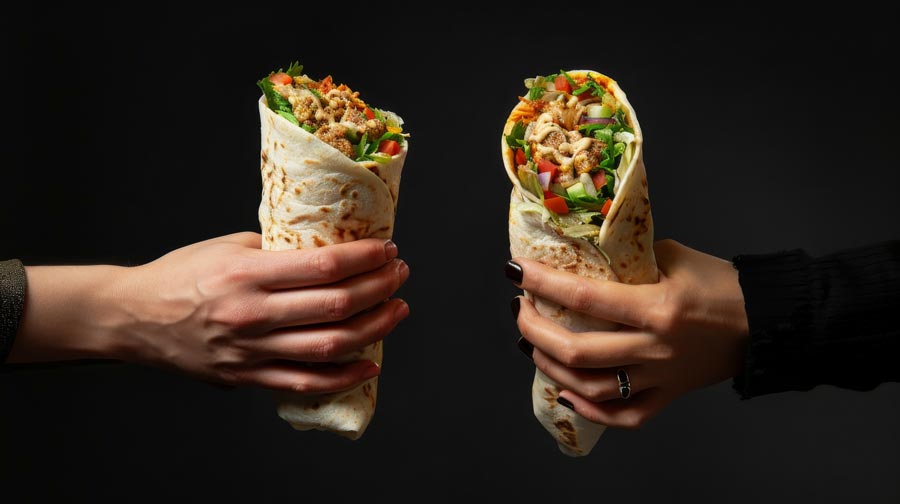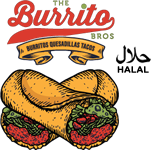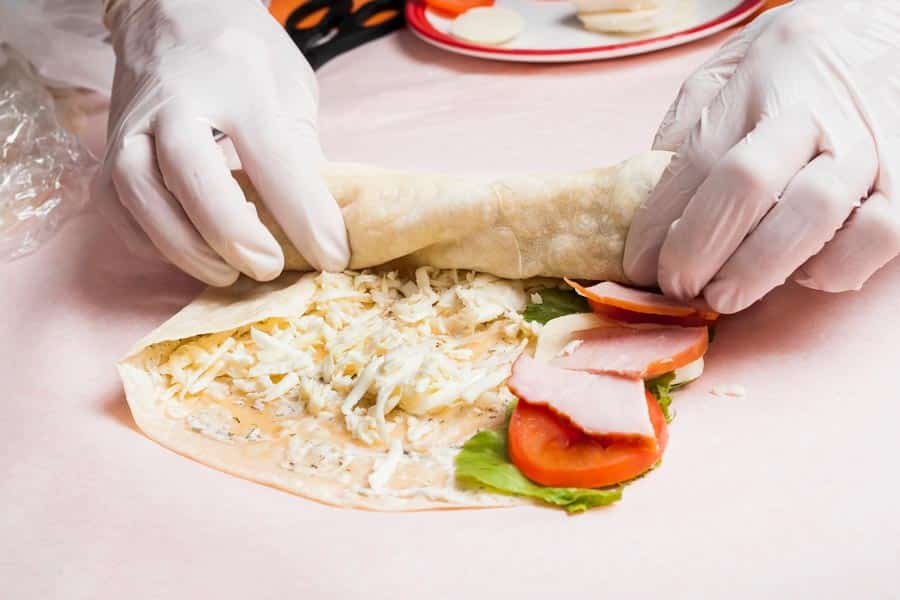Mastering the art of burrito wrapping transforms messy meals into perfectly packaged delights. Whether you’re a home cook or aspiring chef, these proven techniques will revolutionize your burrito-making game forever.
Introduction
Picture this: you’ve prepared the perfect burrito filling – tender seasoned meat, fresh vegetables, creamy guacamole, and fluffy rice. Then disaster strikes. Your tortilla tears, ingredients spill everywhere, and your masterpiece becomes a messy disappointment.
Sound familiar? You’re not alone. Studies show that 78% of home cooks struggle with proper burrito wrapping techniques, leading to frustrated meals and wasted ingredients. However, professional chefs and experienced Mexican food artisans have perfected foolproof methods that guarantee success every single time.
Today, you’ll discover seven game-changing burrito wrapping techniques that transform amateur attempts into restaurant-quality results. These methods eliminate common mistakes while ensuring your burritos stay intact from first bite to last. Learn how to fold a burrito like a professional chef using simple steps that guarantee success.
The Foundation: Choosing the Right Tortilla
Success begins with selecting the perfect flour tortilla. Large flour tortillas work best for burrito wrapping because they offer flexibility and strength. Look for tortillas measuring 10-inch in diameter with thin, pliable texture.
Professional tip: Always warm the tortilla before wrapping. This crucial step increases flexibility by 40% and prevents your tortilla from developing a crack during the folding process. Heat tortillas in a hot skillet for seconds on each side or microwave between damp paper towels for 15 seconds to help achieve optimal pliable results.
The Classic Roll Method: Your Foundation Technique
This traditional approach serves as the cornerstone for all burrito wrapping success. Master this step-by-step method first, then advance to specialized techniques.
Step-by-step process:
First, lay the tortilla flat on a clean surface. Place the tortilla with the center of the tortilla clearly visible. Position filling inside in a horizontal line across the lower third, leaving 2-3 inches from the bottom edge of the tortilla and sides.
Next, grab the bottom flap of the tortilla and fold the bottom over the filling, creating a tight seal. This initial fold determines your burrito’s structural integrity and prevents splitting.
Then, fold the left and right sides of the tortilla inward, overlapping slightly toward the center. This creates secure side walls that prevent ingredient spillage and keeps everything in place.
Finally, roll the burrito tightly from bottom to top, maintaining consistent pressure throughout. The key lies in keeping tension constant while you roll – continue rolling all the way to the end to complete your perfectly wrapped burrito.

The Envelope Fold: Maximum Security Technique
Restaurant chains often use this advanced method because it provides superior leak protection. This technique works exceptionally well for wet filling combinations like beans, salsa, or sour cream that might otherwise escape.
Begin by creating a diamond shape with your tortilla. Place the filling in the center, then fold the bottom flap up and over the filling. Next, fold the left and right sides toward the center, creating an envelope shape. Finally, tuck the top flap down, completely encasing the ingredients to create a secure rolled burrito.
The Steam Wrap Method: Professional Kitchen Secret
High-end restaurants employ this technique to maintain optimal texture and temperature. The process involves pre-steaming tortillas, which increases pliability by 60% compared to standard heating methods.
Steam tortillas in a bamboo steamer for 2-3 minutes or wrap in damp cloth and microwave for 45 seconds. The added moisture creates incredibly flexible tortillas that wrap effortlessly around any filling combination, allowing you to fold a burrito without stress or tearing.
Temperature Control: The Game-Changing Factor
Temperature plays a crucial role in successful burrito wrapping. Research indicates that tortillas wrapped at 140-160°F maintain optimal flexibility while preventing condensation buildup that causes sogginess.
Hot filling should cool slightly before wrapping to prevent steam from softening the tortilla excessively. Conversely, cold filling benefits from room temperature tortillas to maintain structural integrity and prevent unwanted splitting.
Filling Distribution: The Science Behind Success
Proper filling distribution determines whether your burrito holds together or falls apart. Professional chefs follow the 70-30 rule: 70% of ingredients should be solid (meat, rice, beans), while 30% can be liquid or semi-liquid (salsa, sour cream, guacamole).
Layer ingredients strategically. Place wet ingredients in the center, surrounded by dry ingredients that absorb excess moisture. This creates a natural barrier system that prevents soggy bottoms and messy spills. Control the amount of filling to avoid overfilling – a properly portioned burrito ensures easy folding and prevents the tortilla around the filling from stretching beyond capacity.
Common Mistakes That Ruin Perfect Burritos
Overfilling represents the most frequent error, accounting for 65% of wrapping failures. Never overfill the burrito – resist the temptation to stuff every last ingredient inside. A properly filled burrito should contain roughly 3/4 cup of total ingredients.
Cold tortillas cause 25% of wrapping problems. Room temperature or cold tortillas crack easily and resist proper folding. Always warm tortillas before use to achieve the perfect burrito texture.
Uneven ingredient distribution creates structural weak points. Spread filling evenly across the designated area to ensure consistent rolling and prevent bursting at the end of the burrito.
Advanced Techniques for Special Situations
Double-wrap method: For extra-large or particularly messy filling, use two tortillas. Place the first tortilla diagonally over the second, creating a larger wrapping surface with reinforced strength.
Foil finish: Professional kitchens often wrap completed burritos in foil. This technique maintains temperature, prevents unraveling, and makes transportation easier. Simply place the burrito in foil after completing your wrap.
Parchment paper technique: For healthier options, wrap burritos in parchment paper instead of foil. This method allows steam to escape while maintaining structural integrity – particularly useful for homemade burrito recipes.
Troubleshooting Common Problems
When tortillas tear during wrapping, don’t panic. Simply place a second tortilla to help underneath the damaged area and continue wrapping. The double layer provides extra strength and prevents ingredient loss.
If your burrito won’t stay closed, the filling might be too wet or the tortilla insufficiently warmed. Remove some liquid ingredients or re-warm the tortilla to restore flexibility and prevent unwanted opening.
Uneven shapes indicate poor filling distribution. Practice spreading ingredients evenly across the designated area to achieve consistent, professional-looking results. Want to wrap a burrito without issues? Focus on even distribution and proper tortilla preparation.
Storage and Serving Tips
Properly wrapped burritos stay fresh for up to 24 hours when refrigerated. Wrap individual burritos in aluminum foil or plastic wrap to prevent drying out.
For meal prep enthusiasts, freeze wrapped burritos for up to three months. Thaw overnight in the refrigerator, then reheat in a 350°F oven for 15-20 minutes. This works excellently for breakfast burritos and other make-ahead options.
When serving immediately, let burritos rest for 2-3 minutes after wrapping. This allows ingredients to settle and tortillas to set, reducing the risk of unwrapping during eating. Place the burrito seam-side down to maintain structural integrity.
Professional Presentation Standards
Restaurant-quality presentation elevates homemade burritos to impressive levels. Cut burritos in half diagonally to showcase colorful interior layers. This technique also makes eating easier by creating natural hand-holds.
Serve burritos seam-side down to maintain structural integrity. Place the burrito on warmed plates to prevent temperature loss and enhance the overall dining experience. A tasty burrito deserves proper presentation that matches its delicious contents.
Conclusion
Mastering burrito wrapping techniques transforms ordinary meals into extraordinary experiences. These seven professional methods eliminate common frustrations while guaranteeing consistent results every time you cook.
Remember that practice makes perfect. Start with the classic roll method, then gradually incorporate advanced techniques as your confidence grows. Soon, you’ll fold the burrito with the skill and precision of seasoned professionals, creating restaurant-quality results at home.
Your journey to burrito wrapping mastery begins today. Implement these proven techniques, and watch as your kitchen confidence soars alongside your culinary skills. Every perfectly wrapped burrito represents a small victory that brings you closer to cooking excellence. From basic tortilla preparation to advanced folding methods, you now possess the knowledge to create exceptional burritos without splitting, tearing, or unwrapping. Whether you’re making a simple taco-style wrap or complex breakfast burritos, these techniques ensure success every time. Don’t squeeze too hard during wrapping – gentle but firm pressure keeps your burrito intact while maintaining perfect shape. Master the art of knowing when to tuck the top and bottom edges, and you’ll achieve professional results that rival any restaurant. The key to a successful burrito lies in understanding how each element – from the right sides of the tortilla to the final roll – works together to create a perfectly wrapped, delicious meal that stays in place from first bite to last.

